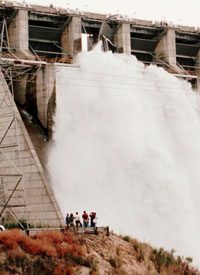
In a culture resounding with motifs of decay and collapse on so many levels, Wired.com is reporting that a breathtakingly large number of dams around the United States have become structurally unsound. Once conceived of as the symbol of man’s “power over nature,” nature is now apparently having the last word. As Alexis Madrigal wrote for Wired.com:
While dams have been built in this country for a couple hundred years, the first half of the 20th century saw a building boom. Large dams were built for hydroelectric power, smaller dams to provide water for industrial concerns or irrigation. There was little state or Federal regulation, particularly of the little dams in small watersheds, until the 1970s, when five major dam failures took hundreds of lives and caused almost $1.5 billion in damage. The Carter administration began to put safeguards in place, but the inspections continue to be carried out at the state level.
Implicit, of course, is the notion that federal inspectors know more, and perhaps even care more, than the people who actually own or oversee such dams and levees — and certainly they know and care more than the people most immediately affected by the dams.
Old age is one of the primary factors contributing to the deteriorating condition of America’s 80,000 dams and levees, which now average more than 50 years since construction. Madrigal writes: “Last year, 140 dams were fixed, but inspectors discovered 368 more that need help. That’s why the American Society of Civil Engineers gave our dams a grade of ‘D’ in its 2009 report on the nation’s infrastructure. There are just too many aging dams and too few safety inspectors. ‘With the huge number of dams getting older every day, it’s becoming a bigger and bigger problem," said Larry Roth, deputy executive director of the ASCE. ‘The policing of maintenance and filing of inspection records is relatively haphazard, not because of lack of focus or knowledge of significance, but they just don’t have the monetary resources to do it.’ ”
After a while, it is really not hard to sense the theme: The "lesson" of Katrina is the answer to every failure of a dam or levee is a bailout, and the "solution" of every imaginable crisis in the past year has been a federal bailout. How much will bailing out our dams cost us? According to Madrigal, “The Association of State Dam Safety Officials estimate that $16 billion would be needed to fix all high-hazard dams. The total for all state dam-safety budgets is less than $60 million. The current maintenance budget doesn’t match the scale of America’s long-term modifications of its watersheds.”
But was not the recent Stimulus/Porkulus Bill supposed to cover such needs? What happened to all of those “shovel ready” works projects the government was going to pay for with money stolen from our grandchildren? According to Wired.com, “Not even the federal stimulus package directed any money to this particular set of shovel-ready projects. By her organization’s [the Association of State Dam Safety’s] count, [Executive Director Lori] Spragens said very little cash from the Recovery Act was going to repair the nation’s dams.”
Thus the catalog of crises continues. Is it possible that a problem exists for which federal regulation and federal funds are not the solution? Many, indeed most, of the dams and levees around this nation are quite local in scope, serving local, even private, interests and affecting a relatively limited community — the overwhelming majority of dams in this country are far from comparison with the massive dams of the American West. Undoubtedly, there is the lure of "free" money at a time when Washington seems to be hemorrhaging cash, but the time has more than come for communities to determine the cost and benefit of local resources.


